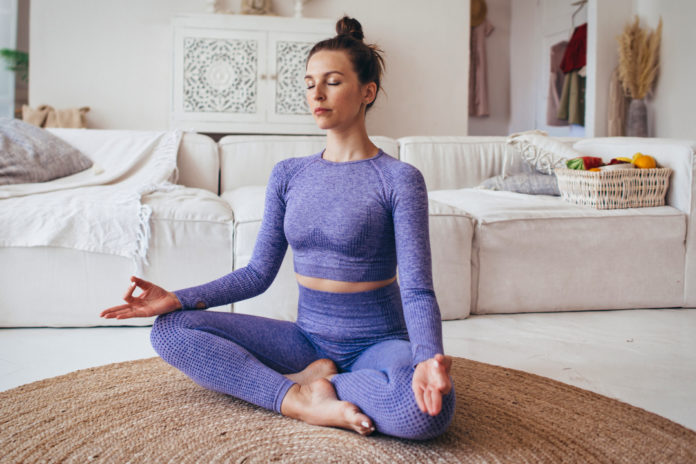Many Yogis consider the breath to be a powerful and essential part of one’s yoga practice. When a yogi can control their breath, they can control their prana or life force energy, which governs all that they think, feel and do. One of the best breathing techniques you can use to create a calm and peaceful mind is Sama Vritti Pranayama. This is a simple but highly effective yoga breathing exercise that can be practiced by just about anyone at just about any time. Mastering this technique will help center your mind to improve your meditation and yoga. Practicing this breath also creates a foundation for learning the more advanced pranayamas.
What is Sama Vritti Pranayama?
Sama Vritti Pranayama is a yoga breathing exercise that is also known as the equal breath or box breathing. Sama means “equal”, and vritti means “mental fluctuations”, so Sama Vritti Pranayama translates as “equal mental fluctuation breathing”. Samavritti pranayama is a ratio breathing technique that uses a set length of equal inhalations, exhalations and breath retentions. The main goal of this technique is to reduce mental chatter and distractions.
The benefits of Sama Vritti Pranayama
The main benefit of this pranayama practice is to equalize, harmonize and balance the prana flowing through the body’s nadis or energy channels. This four-part breathing technique is primarily practiced for calming and balancing the mind and body to reduce mental stress and worry. The conscious use of the diaphragm to increase the flow of air into the lung is a great way to improve your ability to breathe deeply and to bring oxygen to the lungs. Sama Vritti can also help slow down the heart rate, increase oxygen to the brain, and reduce anxiety. People who practice this yoga breathing technique regularly will find they are more focused and are able to experience deep, restful states of relaxation.
Using kumbhaka (breath retention)
An essential part of the Sama Vritti Pranayama it the practice of holding the breath after the inhalation and exhalation. Kumbhaka is a Sanskrit word which translates as “breath retention”. We practice kumbhaka to strengthen our breathing, to stabilize our senses, to increase inner awareness, calm the mind and energize the body. It is important to never hold the breath past the point of discomfort. Advanced yoga students can add one or more bandas with kumbhaka to intensify the practice.
Cautions and contraindications
While Sama Vritti Pranayama is safe, there are a few precautions to know. Pregnant women and people with high blood pressure, lung, heart, eye or ear problems should not hold the retention of breath. Instead, simply work on equalizing the length of the inhalation and exhalation. If you feel dizzy, lightheaded or discomfort, stop and return to a normal relaxed breathing pattern.
When to Use Sama Vritti Pranayama
Sama Vritti Pranayama can be practiced at any point during the day, but the best time to practice is when you are needing to cultivate inner peace, balance and groundedness. Ideally find a quiet spot away from distractions so you can fully focus and tune into your breath. It is recommended to be practiced before other practices, as it will help to prepare the body and mind for yoga asana practice, meditation, and other types of pranayama. You can also use this technique while holding yoga poses to deepen your concentration.
How to practice: step-by-step instructions
- Find your seat — Find a comfortable cross-legged seated position on the floor, with the back of the body straight. Rest the back of your hands on your legs, palms up with the tips of the index finger and thumb touching (Jnana Mudra). Make sure you are not holding tension in your body and take special care to have the shoulders relaxed. If you are not comfortable on the floor, a chair can be used but make sure the feet can rest flat on the floor and the back is straight. You can also practice this lying down on your back, perhaps with the knees slightly raised by placing your legs on a bolster.
- Find your breath — With the mouth closed, inhale and exhale through the nose in a slow, even and continuous flow. Use a diaphragmatic breath so that the belly rises and falls with little or no movement in the chest.
- Set your pace — Slow and deepen your breath as much as comfortable. Most importantly, breathe in and out of the body at your own pace. If you begin to struggle, then shorten the length and number of counts.
- Start your breath cycle
• Inhale for a count of 4.
• Hold the breath in for a count of 4.
• Exhale for a count of 4.
• Hold the breath out for a count of 4. - Find your flow — Repeat the four-part cycle for another 2-6 rounds of breath. When you are comfortable with the practice, you can increase the duration to 10-30 breaths or a maximum of 10 minutes. Only continue as long as you can stay present and focused with the breathing practice.
Practice tips
- For a more advanced version, add ujjayi breathing to your technique. This will add a warming effect and help block out external noise.
- To make this breathing exercise more intense and challenging, you can increase the length of the count up to 6.
- If you find you are struggling with the breath, simply shorten and lower the count to 2 or 3 until it feels easier. You can also remove the holding of breath and simply the breathing cycle with only inhalations and exhalations.
- A daily pranayama practice is recommended to quickly learn this technique and to receive its many benefits.
- Most importantly, do not shift into unequal ratio breathing, as this will affect the quality and benefits of the practice of pranayama. If you cannot maintain an equal ration, it is best to stop, rest for a few breaths, and then try again.


























